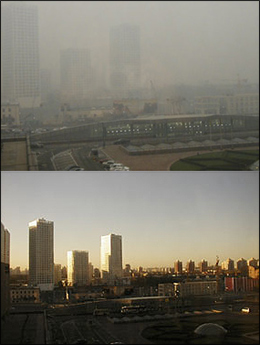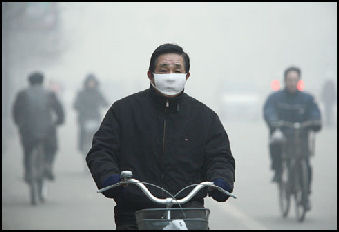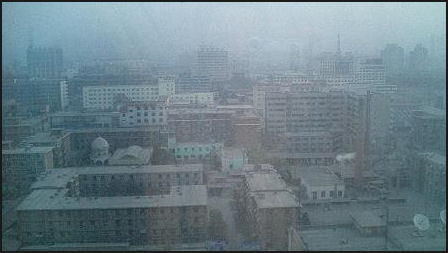China's
environmental protection ministry published a report in 2010 which showed that
about a third of 113 cities surveyed failed to meet national air standards.
According to Chinese government sources, about a fifth of urban Chinese breath
heavily polluted air. Many places smell like high-sulfur coal and leaded
gasoline. The air quality of Beijing is 16 times worse than New York
City.
One
of the main causes is the many industries, metal smelters, and coal-fired power
plants which causes smog. This spews tons of carbon, metals, gases, and
soot into the air. However, these
industries are essential for China’s fast- growing industries. Sometimes
you can't even see building a few blocks away and blue sky is a rare sight. In
Shanghai sometimes you can't see the street from the 5th floor window.
 Beijing on a good and bad day
Beijing on a good and bad day
Especially in urban areas like Beijing and Shanghai,
where more industries are situated at, air pollution and smog in are sometimes
so bad that the airports are shut down because of poor visibility. Once the airport shuts down, many
problems will arise as there is an inconvenience in transport. Many people will
not be able to travel out of China that way, and this delays their activities. Also,
if the airport shuts down because of air pollution, the productivity and
efficiency of the people will be affected. Also, the working force who cannot
travel according to their schedule will be greatly affected and as this leads
to economic decline.
The
amount of airborne suspended particulates in Northern China is almost 20 times above
the considered safe level. This results in many people getting lung
cancer in areas like Benxi where there is the highest rate of lung cancer in
China. To add on, many people, especially men, in China smoke. Smoking which
might result in lung cancer plus the serious air pollution could be detrimental
to the country’s health in general. 300,000 die each year from ambient air
pollution, mostly from heart disease and lung cancer, the leading cause of
death in China. An additional 110,000 die from illnesses related to indoor
pollution from poorly ventilated wood and coal stoves and toxic fumes from
shoddy construction material. In addition, these numbers are expected to
rise.

The
countries air is in such a bad state that the engines of Chinese airlines have
to be overhauled and replaced more frequently than elsewhere because operating
in Chinese air corrodes the turbine blades faster. This also means that
a lot of revenue has to be invested into the consequences of air pollution
which is a disadvantage to China.
The
air pollution also affects tourism in negative ways. Before the 2008 Olympics
found that 74 percent of the Chinese interviewed said they were concerned about
air pollution. in lanzhou, where breathing was almost equivalent to smoking two packs of cigarettes a day
in lanzhou, where breathing was almost equivalent to smoking two packs of cigarettes a day
 in lanzhou, where breathing was almost equivalent to smoking two packs of cigarettes a day
in lanzhou, where breathing was almost equivalent to smoking two packs of cigarettes a day
